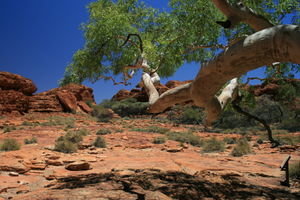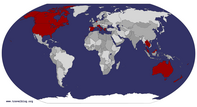Advertisement
Published: February 29th 2008

 Kings Canyon
Kings Canyon
The desert gumLike Jules Verne you cannot help but wonder what lies in the middle as you work your way around Australia. The Red Center and Uluru (Ayers Rock) seem to always be calling both as an iconic symbol of what is Australia and of what lies beyond. It was pointed out to us that 98% of Australia’s population lives along the coastline or a short distance from. This reminded us of Canada in that most of the population is within 4-5 hours of the U.S. border.
So preparing ourselves for both a letdown and new found sense of awe we boarded the Ghan Train as our journey to the red center.
The Ghan so named for the camel riders who made possible the laying of the telegraph line through the red center.
(Camels are not a native animal of Australia but were released after the telegraph line was completed and now number over 60,000. It’s said the camel breed in Australia is a much tougher version then what was originally released. As it turns out camels are now rounded up and sold to the Middle East as prized mounts. Australia seems to have that effect on things.)
So sliding
into our sleeper cabin Clover and I rejoiced at our first mass transit luxury ride. First class on an airplane pales in comparison to having your own sleeper cabin while travelling. Stretching out we found ourselves giddy with excitement as the hours of travel rolled by while we watched the scenery slowly change. Although after 26 hours in small sleeper cabin does tend to make you go a little stir crazy as clover and I found ourselves doing odd things to keep ourselves amused. Nothing like sipping a little Barossa Shiraz while watching ‘Roos wake up to greet the sunset. Originally I’d conceived in my head the notion that going from Adelaide to Alice Springs would be a transition from lush coastal plains that gradually gave way to the one of the world’s greatest barren deserts. Australia is the driest Continent after all, and the red center lies at the heart of this dryness. Rather we found things were quite dry and barren looking soon after leaving Adelaide and 26 hours later the desert actually looked greener and more vibrant than expected. I just love it when things don’t work out like you’ve imagined and turn out better than expected.
So stepping off the train we found it to be hot in Alice Springs but nothing inhuman like we heard it can get up to. From there our journey around Alice Springs was the normal chain of events of head to the hostel, check in, gear up and get ready for heading out. That being said there was something a bit odd about Alice Springs. Nothing I could lay my finger on, just something from the corner of your vision that makes you turn your head from time to time in confusion. It’s a town of around 20,000 out in the middle of nowhere that has a nice little rock ridge bordering one side with desert gums trees all around for shade. I’ve come to love the call of the dry desert towns but as I glanced around I could not help but think that this town with topography and trees had something amiss.
Heading out for several days with our swags (canvas bush sleeping bags and pads) and a group of likeminded individuals we set about to explore Kings Canyon, Uluru, and the Olgas. Needless to say, our first night of sleeping out under the stars proved
to be a big hit as we were finally shown the Southern Cross. Several Ozzies broke into confused discussion about how exactly to determine the southerly direction. Apparently it’s not as easy as finding the North Star and concluding where north lies. Sleeping out under the stars in the outback is absolutely great. It's almost as If you can reach up and draw in the connecting lines on the constellations because the stars are so bright they appear closer then normal.
Uluru and the red center for us seemed to be a swirl of spectacular geology, a spotlight into the aboriginal situation, and luxuries of the modern world. It’s rather tough to explain how an alluvial deposit of arkosic sandstone, the gathering place of the Mala men, and Shiraz by sunset come together. Never the less they all collide here making for us a strange juxtaposition. Here’s my brief attempt.
The geology: A long long time ago you had some serious uplifting that created the Peterman Mountain range. During this time period the area was mostly devoid of any sort of vegetation so you had intensive erosion of the mountains. Out of this you have the two large
washouts of debris that formed (alluvial fans) from the mountains. The closer alluvial fan is composed of large debris and chunks kind of like a minestroni soup that was made from cleaning the kitchen out. This chunky soup rock (Conglomerate) is what makes up the large isolated rocks that are now known as the Olgas. Farther out the second alluvial fan was created in a low lying depression area that resulted in rather well sorted sandstone (Arkosic) creating Uluru. The Olgas and Uluru now stand as isolated giants as they resist erosion quite a bit better then softer laying sediments that made up the shallow sea of the area.
The Aboriginals: Two local tribes call the Uluru region home and have creation myths based around Uluru and the Olgas. Uluru has not only become an iconic symbol for Australia it’s come to represent a symbol for the aboriginal people and their situation in Australia.
(Of interest is that the aboriginal people are estimated to have lived in Australia over 40,000 years making them one of the oldest continued civilizations today. I also find it very interesting that one aboriginal from the very top northwest corner can actually speak
and understand an aboriginal from the very southeast corner. That is such a huge degree of spacial separation over an immense amount of time that it blows the mind. Imagine all of Europe, since it easily fits into Australia or even 80% of the states, all having indigenous people that can understand each other in conversation. Makes me think the Tower of Babel never broke for Australia.)
The Australia government just recently handed over Uluru to the Aboriginals as they work towards making amends to a rough period of history between the settlers and the aboriginals. The tricky thing being that the agreement entitled the Australian government to run Uluru as they wanted for the next 99 years. So the aboriginals own but do not control Uluru which leads to the posted signs asking people to please not climb Uluru. To them it’s like tromping around on top of a super holy mosque in Mecca or even the Holy Ark. None the less every day crowds gather to see if the route to climb Uluru is open. In the aboriginal belief the mala men (half man, half wallaby) made early shamanistic trips to the top for important spiritual ceremonies.
So dying along the trek (36 people so far) really upsets them since Uluru lies on the Dreamline.
To me Uluru is a spectacular geological area, never the less Clover and I agreed we really didn’t have the urge within us to go stomping around on their bible. There’s far more challenging hikes our there without needing to step all over the locals customs and beliefs. For those interested into a glimpse of some of the rough history between aboriginals and the Australian government I’d suggest watching ‘Rabbit proof Fence’. A note of interest: the Australian Government officially said sorry to the aboriginals the day we were out at Uluru. From 1930ish to 1970ish the Australian Government rounded up Aboriginal children and permanently took them thousands of miles to go to white boarding schools in an attempt to “culture” them to European religion and standards of living. Most never saw or heard from their families again. The program proved to be a complete disaster and now across Australia they call them the “Lost Generation.”
Modern Luxuries: Every evening bus loads and bus loads of people pour out into the desert to sip their wine while watching the spectacular
light show displayed on Australia famed red rock. And it is quite amazing to watch the colors play out with sunrise and sunset on Uluru. The latest estimate is that over 750,000 people come to Uluru every year which is no small feat. To go to the red center and Uluru is a deliberate action that takes both a chunk of time and money for literally it lies in the very center of a remote desert wilderness. One explorer (Lancaster I believe) made it to Uluru in the early days almost dead. The local aboriginies helped nurse him back to health and for a while he livied among the tribes taking an interest in their way of life. Unfortunately it was a rough period of drought and after his supplies ran out he was not able to survive on the local food that the aboriginies ate, so he slowly starved to death to thier dismay. Long story short, this is a rough area to survive on if you took away the modern day conviences. Known temps have gone over 52 C (125 F).
So mixing awe inspiring geology with a melancholic aboriginal situation and piles of tourists we found
Uluru to be a dichotomy between the old world and the new. None the less as we explored Uluru, Olgas, and Kings Canyon we felt the pull of the desert as we found gorgeous places to swim and view a surreal landscape. Every moment seemed to be an ocular paradise as the desert pulled your eye to the twisted shapes of ghost gums, the thirsty red sand the shade of paprika, or the monolith rock giants that stand like old guardians.
Advertisement
Tot: 0.056s; Tpl: 0.014s; cc: 11; qc: 27; dbt: 0.0337s; 1; m:domysql w:travelblog (10.17.0.13); sld: 1;
; mem: 1.1mb

















